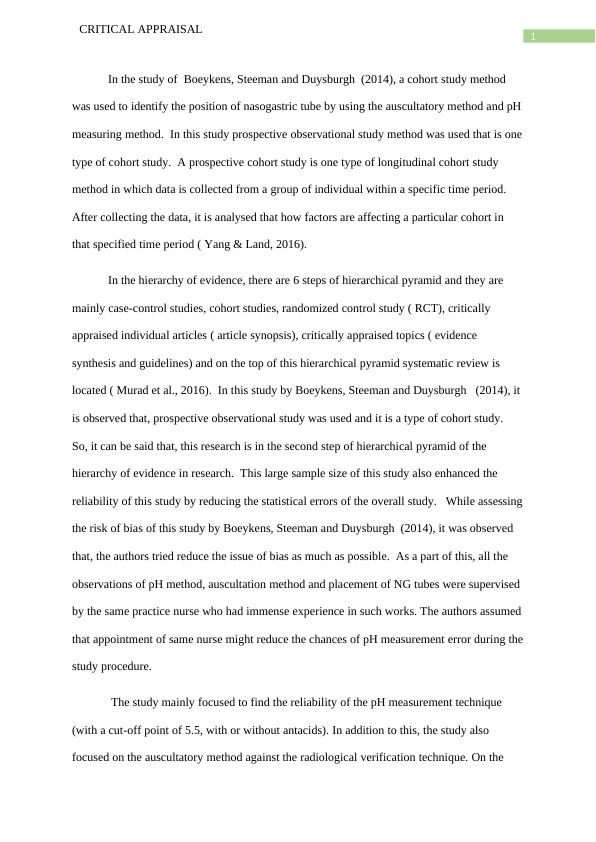Reliability of pH measurement and the auscultatory method to confirm the position of a nasogastric tube
Added on 2023-01-18
8 Pages2026 Words29 Views
Running head: CRITICAL APPRAISAL
Critical Appraisal
Name of the Student
Name of the University
Author Note
Critical Appraisal
Name of the Student
Name of the University
Author Note

1
CRITICAL APPRAISAL
In the study of Boeykens, Steeman and Duysburgh (2014), a cohort study method
was used to identify the position of nasogastric tube by using the auscultatory method and pH
measuring method. In this study prospective observational study method was used that is one
type of cohort study. A prospective cohort study is one type of longitudinal cohort study
method in which data is collected from a group of individual within a specific time period.
After collecting the data, it is analysed that how factors are affecting a particular cohort in
that specified time period ( Yang & Land, 2016).
In the hierarchy of evidence, there are 6 steps of hierarchical pyramid and they are
mainly case-control studies, cohort studies, randomized control study ( RCT), critically
appraised individual articles ( article synopsis), critically appraised topics ( evidence
synthesis and guidelines) and on the top of this hierarchical pyramid systematic review is
located ( Murad et al., 2016). In this study by Boeykens, Steeman and Duysburgh (2014), it
is observed that, prospective observational study was used and it is a type of cohort study.
So, it can be said that, this research is in the second step of hierarchical pyramid of the
hierarchy of evidence in research. This large sample size of this study also enhanced the
reliability of this study by reducing the statistical errors of the overall study. While assessing
the risk of bias of this study by Boeykens, Steeman and Duysburgh (2014), it was observed
that, the authors tried reduce the issue of bias as much as possible. As a part of this, all the
observations of pH method, auscultation method and placement of NG tubes were supervised
by the same practice nurse who had immense experience in such works. The authors assumed
that appointment of same nurse might reduce the chances of pH measurement error during the
study procedure.
The study mainly focused to find the reliability of the pH measurement technique
(with a cut-off point of 5.5, with or without antacids). In addition to this, the study also
focused on the auscultatory method against the radiological verification technique. On the
CRITICAL APPRAISAL
In the study of Boeykens, Steeman and Duysburgh (2014), a cohort study method
was used to identify the position of nasogastric tube by using the auscultatory method and pH
measuring method. In this study prospective observational study method was used that is one
type of cohort study. A prospective cohort study is one type of longitudinal cohort study
method in which data is collected from a group of individual within a specific time period.
After collecting the data, it is analysed that how factors are affecting a particular cohort in
that specified time period ( Yang & Land, 2016).
In the hierarchy of evidence, there are 6 steps of hierarchical pyramid and they are
mainly case-control studies, cohort studies, randomized control study ( RCT), critically
appraised individual articles ( article synopsis), critically appraised topics ( evidence
synthesis and guidelines) and on the top of this hierarchical pyramid systematic review is
located ( Murad et al., 2016). In this study by Boeykens, Steeman and Duysburgh (2014), it
is observed that, prospective observational study was used and it is a type of cohort study.
So, it can be said that, this research is in the second step of hierarchical pyramid of the
hierarchy of evidence in research. This large sample size of this study also enhanced the
reliability of this study by reducing the statistical errors of the overall study. While assessing
the risk of bias of this study by Boeykens, Steeman and Duysburgh (2014), it was observed
that, the authors tried reduce the issue of bias as much as possible. As a part of this, all the
observations of pH method, auscultation method and placement of NG tubes were supervised
by the same practice nurse who had immense experience in such works. The authors assumed
that appointment of same nurse might reduce the chances of pH measurement error during the
study procedure.
The study mainly focused to find the reliability of the pH measurement technique
(with a cut-off point of 5.5, with or without antacids). In addition to this, the study also
focused on the auscultatory method against the radiological verification technique. On the

2
CRITICAL APPRAISAL
other hand the secondary objective of this study is to assess the practicability or feasibility of
this in comparison with the pH measurement technique (Boeykens, Steeman & Duysburgh,
2014). The study of Yıldırım et al. (2018), also reported that, the auscultation method is one
of the common technique of checking appropriate placement of NG tubes among the patients.
This study also investigated the effectiveness of auscultation techniques among the patients
with NG tubes. The previous method was not appropriate as the presence of antacid
medication can enhance the gastric pH and this pH enhancement is also observable in the
respiratory placement ( Sun et al., 2015). So it is difficult to locate the position of NG tubes
by using only the pH measurement technique. In addition to this, when the NG tube is placed
in the stomach it is not possible to detect the exact location of the NG tubes as this technique
cannot detect that whether the tube is located near the fundus or near the cardiac sphincter
and this may associated with the complications related to the feeding. Moreover, the low cut-
off level of pH positioning is marked as poor technique as it has very poor level of sensitivity.
In a prospective cohort study, there is five steps and they are identifying the cohort
population or study subjects, obtaining the baseline data on the exposure that is measuring the
exposure level at the initiation of the study, selecting sub-classification of the cohort study,
measuring the outcomes by using previous record and the final step is analysing the data
collected from the overall study. In this study by Boeykens, Steeman and Duysburgh (2014),
it was observed that, the first step that is identifying the study population was maintained in a
proper way as the authors conducted the study at the AZ Nikolaas Hospital in Sint-Niklaas
(Belgium) in between 2009 to 2012. Almost 331 NG tubes were placed in 314 patients who
were admitted in the hospital without any other medical complications. In addition to this all
the baseline data of the patients were collected and even the information regarding intaking of
proton pump inhibitors were also collected as baseline data of the patients. The next step of
the cohort study was not also followed in an accurate manner. Hence there was no
CRITICAL APPRAISAL
other hand the secondary objective of this study is to assess the practicability or feasibility of
this in comparison with the pH measurement technique (Boeykens, Steeman & Duysburgh,
2014). The study of Yıldırım et al. (2018), also reported that, the auscultation method is one
of the common technique of checking appropriate placement of NG tubes among the patients.
This study also investigated the effectiveness of auscultation techniques among the patients
with NG tubes. The previous method was not appropriate as the presence of antacid
medication can enhance the gastric pH and this pH enhancement is also observable in the
respiratory placement ( Sun et al., 2015). So it is difficult to locate the position of NG tubes
by using only the pH measurement technique. In addition to this, when the NG tube is placed
in the stomach it is not possible to detect the exact location of the NG tubes as this technique
cannot detect that whether the tube is located near the fundus or near the cardiac sphincter
and this may associated with the complications related to the feeding. Moreover, the low cut-
off level of pH positioning is marked as poor technique as it has very poor level of sensitivity.
In a prospective cohort study, there is five steps and they are identifying the cohort
population or study subjects, obtaining the baseline data on the exposure that is measuring the
exposure level at the initiation of the study, selecting sub-classification of the cohort study,
measuring the outcomes by using previous record and the final step is analysing the data
collected from the overall study. In this study by Boeykens, Steeman and Duysburgh (2014),
it was observed that, the first step that is identifying the study population was maintained in a
proper way as the authors conducted the study at the AZ Nikolaas Hospital in Sint-Niklaas
(Belgium) in between 2009 to 2012. Almost 331 NG tubes were placed in 314 patients who
were admitted in the hospital without any other medical complications. In addition to this all
the baseline data of the patients were collected and even the information regarding intaking of
proton pump inhibitors were also collected as baseline data of the patients. The next step of
the cohort study was not also followed in an accurate manner. Hence there was no

End of preview
Want to access all the pages? Upload your documents or become a member.
Related Documents
Safety of Nasogastric Tube Insertionlg...
|14
|4313
|348
Confirmation of Nasogastric Tube Placement Case Study 2022lg...
|15
|3654
|30
Critical Appraisal of Articlelg...
|10
|2111
|232
